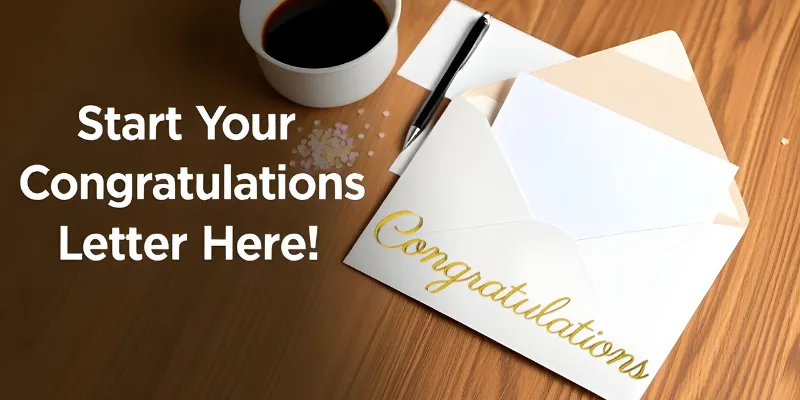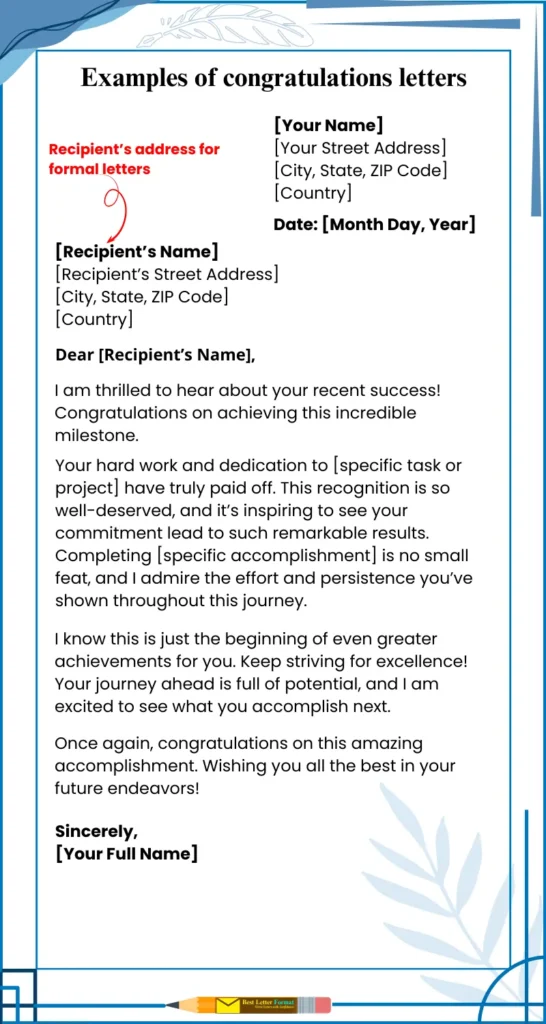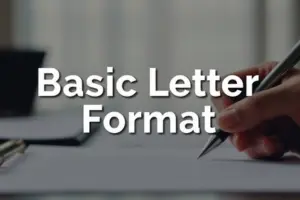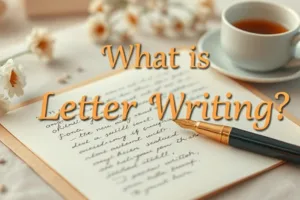Learn to Write the Perfect Congratulations Letter Step by Step
Published: 23 Dec 2024

Expressing happiness for someone’s success can feel difficult when words don’t seem personal or sincere enough. This often leads to missed chances to strengthen relationships.
A congratulations letter solves this problem by adding a thoughtful and personal touch. It shows genuine care, celebrates achievements, and deepens connections, whether with a friend, family member, or colleague.
If you’re ready to learn how to write a letter like this, you’re in the right place. This guide will help you write a message that’s personal, engaging, and tailored to the occasion. From structure to tone, you’ll learn all the key elements to create a letter that truly stands out. Let’s get started!
1. What is a Congratulations Letter?
A congratulations letter is a thoughtful message written to celebrate someone’s success or achievement. It can be a formal letter for professional milestones, such as a job promotion or academic success, or an informal note for personal events like engagements or anniversaries.
The purpose of a congratulations letter is to acknowledge and appreciate the recipient’s hard work and dedication, making them feel valued and celebrated. Whether sent through email, a handwritten note, or even a printed card, this gesture conveys genuine encouragement and strengthens bonds.
In short, a congratulations letter is a simple yet powerful way to share in someone’s joy and make their special moments even more memorable.
2. Types of Congratulations Letters
Congratulations letters can be tailored to suit various occasions and relationships. Whether you’re celebrating a professional milestone or a personal achievement, understanding the context helps you strike the right tone. Below, we explore different types of congratulations letters to help you write the perfect message.
Formal Congratulations Letters
These letters are used in professional settings and follow a structured tone to maintain professionalism. Here are 10 examples:
- Congratulating an employee on a job promotion.
- Acknowledging a colleague for completing a major project.
- Writing to a business partner for achieving a milestone anniversary.
- Sending appreciation to a team for winning a corporate award.
- Recognizing a client for expanding their business operations.
- Congratulating someone for receiving a professional certification.
- Writing to a university graduate for securing a high-ranking position.
- Sending congratulations for completing an MBA or higher degree.
- Acknowledging a CEO for being featured in industry news.
- Writing to an organization for launching a new product or service.
Informal Congratulations Letters
Casual and personal, these letters celebrate milestones with warmth and affection. Here are 10 examples:
- Congratulations to a friend on their engagement or wedding.
- Writing to a family member on graduating high school.
- Sending warm wishes for buying a new home.
- Acknowledging a loved one for welcoming a new baby.
- Congratulating a friend for winning a sports tournament.
- Writing to a sibling for starting a new job.
- Sending a note to a friend for completing a creative project.
- Recognizing someone for receiving a local community award.
- Congratulating a friend for achieving a personal fitness goal.
- Writing to someone who has successfully published a book.
Congratulatory Notes or Cards
Short and sweet, these are perfect for quick messages to recognize small victories or day-to-day achievements. Examples include:
- Writing a note for completing a short-term course or workshop.
- Congratulating someone for receiving an employee of the month award.
- Acknowledging participation in a charity event.
- Sending a card for winning a small competition or raffle.
- Congratulating a friend for hosting a successful event or party.
- Writing a quick note for achieving a personal best in sports.
- Acknowledging someone for being featured in a local magazine.
- Congratulating a coworker for completing their probation period.
- Sending a card for a successful presentation or pitch.
- Writing a note for someone starting a new hobby.
3. General Structure of a Congratulations Letter
Here’s a versatile structure that works for any type of congratulations letter, whether formal or informal and for various occasions:
1. Sender’s Address
Write your address at the top-left corner of the letter.
Example:
[Your Name]
[Your Street Address]
[City, State, ZIP Code]
[Country] (if applicable)
2. Date
Write the date below your address to specify when the letter was written.
Example:
[Month Day, Year]
e.g., December 23, 2024
3. Recipient’s Address
Include the recipient’s address below the date (for formal letters). Skip this in informal letters.
Example:
[Recipient’s Name]
[Recipient’s Street Address]
[City, State, ZIP Code]
[Country] (if applicable)
4. Greeting
Start with a warm and personal greeting.
Example:
- “Dear [Name],”
- “Hi [Name],”
5. Opening Line: Express Happiness
Begin by acknowledging their achievement with enthusiasm.
Example:
- “I am so happy to hear about your fantastic achievement!”
- “Congratulations on this wonderful milestone—you truly deserve it!”
6. Body: Celebrate the Achievement
Discuss their success with specific details. Keep it sincere and encouraging.
Example:
- “Your hard work and dedication in [specific area] have truly paid off. This recognition is well-earned!”
- “It’s amazing to see your efforts in [specific project/achievement] being appreciated by so many.”
7. Encouragement for the Future
Offer inspiring words to motivate them for their future endeavors.
Example:
- “I’m confident this is just the beginning of even greater accomplishments.”
- “Keep up the amazing work—I’m excited to see what you achieve next!”
8. Closing: End on a Warm Note
Finish the letter with kind wishes for their continued success.
Example:
- “Once again, congratulations on this incredible achievement. Wishing you all the best!”
- “Looking forward to celebrating more of your successes—congratulations!”
9. Signature
End with a professional or friendly closing, depending on the relationship.
Example:
- “Warm regards, [Your Name]”
- “Best wishes, [Your Name]”
- “Sincerely, [Your Name]”
4. Examples of congratulations letters
Here’s a complete format for a congratulations letter that can be tailored to any occasion. It includes all necessary sections for formal and informal use:
[Your Name]
[Your Street Address]
[City, State, ZIP Code]
[Country]
Date: [Month Day, Year]
[Recipient’s Name]
[Recipient’s Street Address]
[City, State, ZIP Code]
[Country]
Dear [Recipient’s Name],
I am thrilled to hear about your recent success! Congratulations on achieving this incredible milestone.
Your hard work and dedication to [specific task or project] have truly paid off. This recognition is so well-deserved, and it’s inspiring to see your commitment lead to such remarkable results. Completing [specific accomplishment] is no small feat, and I admire the effort and persistence you’ve shown throughout this journey.
I know this is just the beginning of even greater achievements for you. Keep striving for excellence! Your journey ahead is full of potential, and I am excited to see what you accomplish next.
Once again, congratulations on this amazing accomplishment. Wishing you all the best in your future endeavors!
Sincerely,
[Your Full Name]

5. Pros and Cons of Writing a Congratulations Letter
A well-written congratulations letter can have a lasting impact, but like any form of communication, it has its strengths and limitations. Here’s an honest look at its advantages and drawbacks:
| Advantages of Writing a Congratulations Letter |
|---|
|
| Drawbacks of Writing a Congratulations Letter |
|---|
|
6. Common Mistakes to Avoid in a Congratulations Letter
When writing a congratulations letter, avoiding common mistakes can make your message more impactful. Here are some pitfalls to watch out for, along with tips to improve:
- Over-Exaggerating or Being Insincere: Avoid using excessive praise or over-the-top statements that may come across as fake.
Tip: Keep your tone genuine by focusing on the specific achievement and expressing honest admiration. - Using Generic Phrases Without Personal Touches: Generic congratulations like “Well done!” or “Great job!” feel impersonal and lack emotional depth.
Tip: Add specific details about the accomplishment to make your message more meaningful. For example, mention how their hard work led to success. - Making the Letter Too Long or Too Short: An overly lengthy letter can lose the reader’s attention, while a very short one may seem rushed or insincere.
Tip: Write 3-4 well-structured paragraphs, balancing brevity with enough detail to show genuine care. - Ignoring the Tone: Writing in a tone that’s too formal or too casual can make the letter feel inappropriate for the occasion or relationship.
Tip: Match your tone to the context. Use a professional tone for workplace achievements and a warm, personal tone for friends or family. - Skipping Proofreading: Typos, grammatical errors, or unclear sentences can make your letter seem careless or rushed.
Tip: Always proofread your letter to ensure clarity and correctness. Reading it aloud can help catch errors.
By following these tips and avoiding these mistakes, your congratulations letter will feel personal, polished, and impactful, leaving a positive impression on the recipient.
7. FAQs about Writing a Congratulations Letter
Here are some commonly asked questions about writing a congratulations letter, along with concise answers to help you:
A congratulations letter is used to celebrate someone’s achievement, acknowledge their success, and show appreciation or support.
Write it for occasions like job promotions, graduations, weddings, new babies, or personal milestones.
Use a tone that suits the relationship—formal for professional achievements and warm or casual for personal ones.
Keep it concise, typically 3-4 short paragraphs, ensuring it’s heartfelt and to the point.
Mention the specific achievement, express genuine praise, and add a personal or encouraging message for the future.
Yes, an email works well for both formal and informal situations, especially when time is a factor.
A handwritten letter adds a personal touch and is ideal for close relationships or special milestones.
For major achievements, adding a small gift or token of appreciation can make the gesture even more memorable.
Avoid generic phrases, exaggeration, and mistakes in tone or grammar. Always make it personal and sincere.
Yes, a general structure works for most letters, but make sure to customize the details for the recipient and occasion.
Conclusion
Writing a congratulations letter is a meaningful way to celebrate achievements and strengthen relationships. In this guide, we explored the art of crafting thoughtful and impactful letters. Here’s a quick recap of what we covered:
- What is a Congratulations Letter?
We learned how this thoughtful gesture acknowledges achievements and deepens bonds. - Types of Congratulations Letters:
Formal, informal, and short notes—each tailored to specific occasions with examples for clarity. - General Structure:
A step-by-step framework to write heartfelt letters with addresses, greetings, and personal touches. - Examples:
Sample formats to inspire your writing, adaptable for various situations. - Pros and Cons:
The strengths of these letters and how to overcome common challenges. - Common Mistakes to Avoid:
Practical tips to ensure your letter feels genuine, engaging, and error-free.
By following these steps, you can create a letter that not only celebrates success but also leaves a lasting impression. Whether it’s for a job promotion, graduation, or personal milestone, a well-written letter shows your care and thoughtfulness.
Your Turn!
What kind of congratulations letter format do you need? Let us know in the comments, and we’ll create a custom template just for you! 😊
Also, share what you’ve learned from this guide—did any specific tip or section stand out? We’d love to hear your thoughts!

- Be Respectful
- Stay Relevant
- Stay Positive
- True Feedback
- Encourage Discussion
- Avoid Spamming
- No Fake News
- Don't Copy-Paste
- No Personal Attacks

- Be Respectful
- Stay Relevant
- Stay Positive
- True Feedback
- Encourage Discussion
- Avoid Spamming
- No Fake News
- Don't Copy-Paste
- No Personal Attacks








